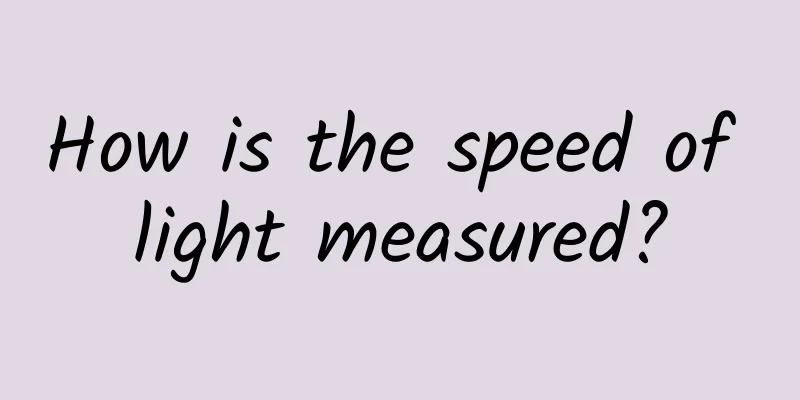How is the speed of light measured?

|
Everyone knows that light travels very fast, traveling 300,000 kilometers in one second, and circling the earth seven and a half times in one second. How do humans measure such a fast speed? 1. Galileo's Measurements In ancient Greece, people were not very clear about the magnitude of the speed of light. Some scientists, such as Aristotle, even believed that the speed of light was infinite. What's even more interesting is that some people believed that light is emitted from the eyes, and we can see distant stars as soon as we open our eyes, so the speed of light must be infinite. After the Renaissance, Galileo, a pioneer of modern science, conducted the first experiment to measure the speed of light in 1638. Galileo and his assistant stood on two hills far apart, each holding a lamp. Galileo covered his lamp first, and when his assistant saw Galileo cover his lamp, he immediately covered his own lamp. Galileo's idea was to measure the time difference between covering his lamp and seeing his assistant cover his lamp. During this time, the light just traveled back and forth between the two people, so the speed of light could be measured. However, the speed of light is so fast that it is impossible to measure the speed of light in this experiment. If we ignore the reaction time of the two people and the time to cover the light, it only takes a few microseconds for light to travel this distance, which is impossible to measure with the equipment conditions at that time. Galileo also admitted that he did not measure the speed of light through this experiment, nor did he determine whether the speed of light is finite or infinite. However, Galileo said: "Even if the speed of light is finite, it must be incredibly fast." 2. Using Jupiter to measure the speed of light The real measurement of the speed of light began with Danish astronomer Ole Rømer. In 1610, Galileo used his improved telescope to discover four satellites of Jupiter, of which Io is the closest to Jupiter, orbiting Jupiter once every 42.5 hours. Moreover, the orbital plane of Io is very close to the orbit of Jupiter around the sun, so sometimes Io will turn to the back of Jupiter, and the sun's light cannot shine on Io, so people on Earth cannot see this satellite, which is called Io eclipse. Let's look at a diagram. The Earth moves counterclockwise around the Sun A in a circular orbit FGLK, and Io also moves counterclockwise around Jupiter B. The area between CD behind Jupiter is Jupiter's shadow. If Io enters this part of the shadow, the sunlight cannot reach it, and people cannot see it. In other words, when Io reaches point C, it will disappear, which is called "disappearance". If Io comes out of the shadow, it can be observed, that is, when Io reaches point D, it will appear, which is called "appearance". Romer used this phenomenon to measure the speed of light. First, we study the disappearance and reappearance of the Earth as it passes close to Jupiter. When Io reaches point C, it enters the shadow. The light of this phenomenon needs to travel a certain distance to reach the Earth. Assuming that the Earth is at point F when the light travels from C to the Earth, then people observe the disappearance phenomenon a little later than the time when Io enters the shadow. This time is equal to the ratio of the length of CF to the speed of light. When Io reaches point D, it will leave the shadow and reflect the sunlight again. It will take some time for this phenomenon to reach the Earth. Since the Earth is moving, assuming that the Earth is at point G when this beam of light reaches the Earth, then the time people observe the phenomenon of the current is also a little later than the time when Io leaves the shadow. This time is equal to the ratio of the length of DG to the speed of light. However, since CF is longer than DG, the delay of the disappearance phenomenon is longer than that of the appearance phenomenon, that is, the disappearance is discovered later and the appearance is discovered earlier. The time interval between disappearance and appearance is shorter than the time that Io is in the shadow. We can use a line segment graph to represent this relationship. Similarly, we can discuss the disappearance and reappearance of the Earth as it moves away from Jupiter. If the Earth finds Jupiter disappearing when it reaches L and reappears when it reaches K, since the Earth is moving away from Jupiter, the length of LC will be smaller than the length of KD. If the Earth discovers the disappearance earlier and the reappearance later, the time interval between the disappearance and reappearance will be longer than the actual time Io is in Jupiter's shadow. From 1671 to 1673, Rømer conducted many observations and concluded that when the Earth was moving away from Jupiter, the time difference between disappearance and reappearance was 7 minutes longer than when it was approaching, and concluded that the speed of light was in the order of magnitude. Although Newton and Huygens, two great scientists, argued endlessly about whether light is a particle or a wave, they both supported Romer's method in measuring the speed of light. Newton also measured that it takes 8 minutes for light to travel from the sun to the earth, which means that the sun we see is the sun from 8 minutes ago. 3. Michelson and Foucault Experiments 200 years later, the first person to significantly improve the accuracy of measuring the speed of light was American physicist Michelson. From 1877 to 1879, Michelson improved the rotating mirror invented by Foucault. The schematic diagram is as follows: Schematic diagram of Michelson's device for measuring the speed of light Michelson placed an octahedron M1 and a reflector M2M3 at two locations far apart, allowing a beam of light to be reflected by the mirror surface 1 in the octahedron and then reflected back to the octahedron through M2 and M3, and then reflected by the mirror surface 3 before entering the observation eyepiece. Only when the octahedron is in the position shown in the figure will there be light in the observation eyepiece. If the octahedron is rotated a little, the light reflected by the interface 1 will not be able to illuminate M2, and no light will be seen in the observation eyepiece. If the octahedron is rotated and the angular velocity is gradually increased, it will be found that light can be seen from the observation eyepiece at a certain angular velocity. This is because when interface 1 is tilted at a 45-degree angle, the light is reflected by interface 1 and reaches M2. When it returns to the octahedron, the octahedron rotates just one grid (1/8 cycle), so interface 2 just runs to the position of mirror 3 in the figure, reflecting the light into the observation eyepiece. Due to the persistence of vision, it seems that light can always be seen in the observation eyepiece. Assuming that the distance between the left and right devices is L, when the rotation period of the octahedron is T, light can be seen from the observation mirror. Since L is much longer than the length of other parts, the distance that the light travels from interface 1 to the left and then back to the octahedron is approximately S=2L According to the analysis just now, the light moves back and forth once, and the octahedral mirror just travels one grid, and the time t=T/8 So the speed of light is Based on this principle, Michelson measured the speed of light to be 299853±60km/s, which is very close to the more precise value we measure today. Now, people use more precise methods to measure the speed of light in a vacuum as 299792458m/s, and use the speed of light to define the concept of "meter". 1 meter is equal to the distance that light travels in a vacuum in 299792458th of a second. If the distance is very large, people use the concept of light years: 1 light year is equal to the distance that light travels in one year, approximately. We can see stars millions of light years away because those stars began to shine millions of years ago, and the light they emit has not reached the earth until today. In other words, what we see is what they looked like millions of years ago, and whether they still exist today is still unknown! END Source: Mr. Li Yongle |
<<: Where does the space station's oxygen come from?
>>: What should I do if the itinerary card has a "*"? Do I need to be quarantined for 14 days?
Recommend
How to avoid "playing the lute to a cow" in traffic promotion?
Who are you asking for traffic from? In ancient t...
The most noteworthy tips on using Apple ID password
What is an Apple ID? You can use it to change you...
What? Your brain will freeze? Be careful when eating this kind of food!
Edit: April Recently, all parts of the country ha...
Will cars become less safe after being lightweight? Safety and lightweight can be improved together
One of the development directions of the automobi...
How do you start to create an offline event?
1. To organize a successful offline event , we ne...
Lin Dan admitted to cheating! Brands are all thinking, who should be the next spokesperson?
Lin Dan cheated on his wife, and many people are ...
What is the difference between Hong Kong servers and domestic mainland servers?
In recent years, more and more users choose Hong ...
Hu Q&A: Can a puppy understand what you say?
"Come on, come on, puppy, puppy, suck, suck!...
What happens if you eat food that is one month past its expiration date?
When we encounter slightly expired food, we would...
Cognitive neuroscience: self and social intelligence
Self and Social Intelligence ——A person has many ...
Event Operation: How to achieve high conversion rate through poster copywriting?
Operations staff often come into contact with eve...
2021 hot marketing calendar for the whole year! Hot spot analysis included
Whether you are doing new media operations, marke...
2015 App Operation and Promotion Strategy (Full Version)
The basic tone of the APP operation and promotion...
Huawei responds to US ban on Chinese 5G: Restricting Huawei will not make the US stronger
[[265442]] The US blockade of China's 5G tech...
Tobacco is sweet? Diabetes warning!
Author: Xiao Dan, Director of the Department of T...









